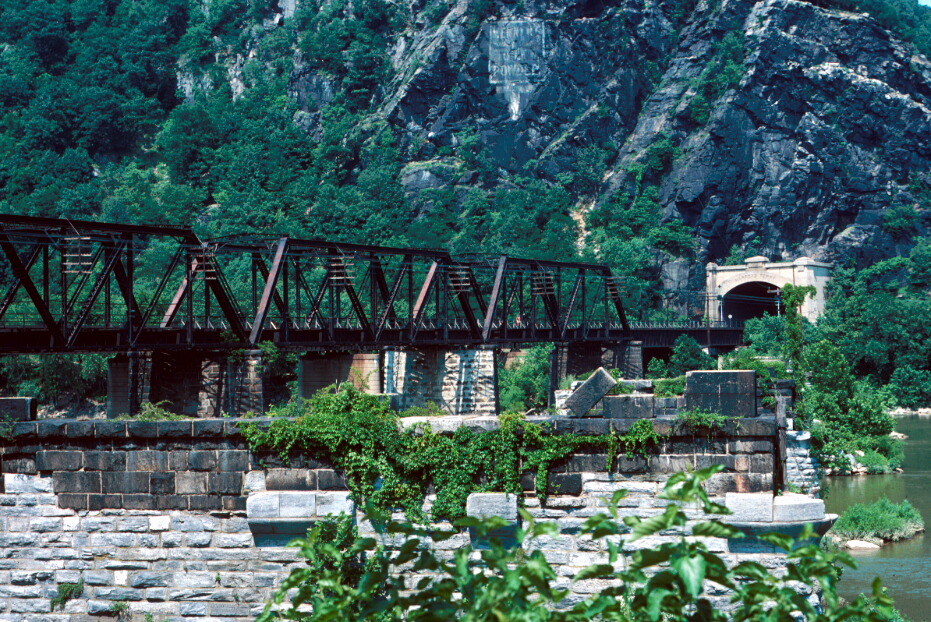
Photo credit:
Paula Stoner Dickey, 07/1978
|
B & O Railroad Potomac River Crossing
Inventory No.:
WA-III-027
Date Listed:
2/14/1978
Location:
B&O Railroad over Potomac River, Harpers Ferry Road , Knoxville, Washington County
Category:
Site,Structure
Period/Date of Construction:
1836; 1851; 1894; 1931
Architect/Builder:
Builders: Benjamin H. Latrobe; Louis Wernwag; Wendel Bollman; William Lee Sisson
|
|
Description:
The Baltimore and Ohio Railroad, now part of CSX, crosses the Potomac River and the C&O Canal between Harpers Ferry, West Virginia and Maryland Heights in Washington County, Maryland. The crossing is in an east-west direction. On the Maryland side of the river the land rises abruptly to form the southern end of Elk Ridge, known as Maryland Heights. As a result of the land formation, a tunnel takes the railroad through the southern tip of Maryland Heights. Although the B & O Railroad crossed the Potomac at this location as early as 1836, what remains at present are the two most recent railroad bridges, still in use, and ruins of the piers of two earlier bridges which shared the same alignment. The two existing bridges converge on the Maryland side of the river at the western end of the tunnel. The most recent and northernmost bridge was built in 1930-1931. It is a deck plate-girder span which carries the B & O main line. The construction of this bridge was part of a new alignment which reduced sharp curves associated with the river and canal crossing. As part of this improvement project, the tunnel was given its present bell mouth of reinforced concrete to accommodate the new alignment. Just south of the 1931 bridge is a steel-truss and plate-girder bridge completed in 1894 for the Valley Branch of the B & O Railroad. According to Engineer William Lee Sisson, who planned the bridge and approach alignments in 1894, the bridge consists of four deck spans of 85'-6", three through spans of 140', one deck span of 100', and one half-through span of 34'-6", making a total length of 896'-6". The eight piers of the bridge, built of Gettysburg granite, are set in line with the piers of the old bridge, so as to obstruct the waterway as little as possible. The bridge has through-spans of single-intersection Pratt trusses, with deck spans of plate girders. The west end of the bridge branches into a "Y" at the junction of the main line and the Valley (Winchester) Branch of the B & O Railroad. At the time this bridge was built, the tunnel was constructed to eliminate a sharp curve between the C&O Canal and the foot of Maryland Heights. The double-track tunnel is 812' long and begins 103 feet from the east end of the bridge. Its original portals were of brick. Ruins of the abutments of two earlier bridges stand in the water south of the 1894 bridge. The more recent of these ruins was the famous Bollman Iron Truss bridge, completed in 1870, and used by rail and highway traffic until 1894, and by highway traffic alone until it was destroyed by the flood of 1936. The original railroad bridge was a covered timber structure built in 1836-1837, designed by Benjamin H. Latrobe, the B & O's Chief Engineer, and built by Lewis Wernwag. Before the railroad bridges were built, a highway bridge, begun in 1824, crossed the river between Harper's Ferry and Maryland Heights. A ferry crossed the Potomac and was in operation as early as 1747.
|
Significance:
Present on the site is the physical evidence of three separate and distinct alignments of the Baltimore & Ohio's main line at its crossing of the Potomac. All of these sites and structures are the result of transportation needs which have expanded over the past two centuries. The sequence of river and canal crossings illustrates the development of engineering skills, the invention of new bridging systems, and the architectural considerations associated with them. The remaining bridges and bridge piers reflect the significance of this crossing to commercial, industrial, and economic development brought about by the growth of railroads during the 19th and early 20th centuries.
|
|